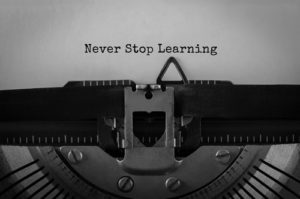[Editor’s note: This piece originally appeared on the Christensen Institute’s site and is reposted here with permission.]
The shelf life of skills is shortening in today’s workforce. Automation is creeping into most sectors; the gig economy is booming; and all of these developments require that workers upskill, reskill, and master soft skills.
Colleges and universities play an integral role in delivering some of these skills, but they fall woefully short in delivering on the country’s lifelong learning needs. How can education providers and companies bridge the gap between the traditional, front-loaded educational experience and the ever-evolving needs of an increasingly fast-paced and turbulent economy and society?
Related content: Educators should prepare students for lifelong learning
One suitcase versus an evolving wardrobe
There is a tendency to see the transition between higher education and the workforce, from a skills acquisition perspective, as packing all your belongings from college into one suitcase, getting your first job, and then…that’s it. You unpack, settle down, and never have to pack again. If you need anything else, your employer takes care of it. This leads educational institutions, government agencies, and many companies to imagine a single, modular interface between college and a first job, and to behave as if higher education’s role is done after the graduation ceremony.
This “pack once for the long haul” model may have worked fine when job responsibilities evolved more slowly, and when companies invested in keeping and training employees for the long haul as a default expectation. However, it breaks down in the face of today’s frenetic economy, which requires more frequent and flexible learning options from various providers to provide skills-on-the-go.
A more robust visual model would have you regularly relocating with an evolving wardrobe, indefinitely. It’s entirely unreasonable to think that one initial packing would contain all the clothes you’ll need for every phase of your journey. At times, you’ll acquire new items. At other times, you’ll hire someone to mend or adjust your existing clothes. There may even be times where an employer gives you a uniform and takes care of everything uniform-related. The opportunities to update your wardrobe are many and diverse, and you’ll continually interface with them throughout your life to keep your suitcase relevant to your needs.
Opportunities abound for higher education
A better understanding of the lifelong learning paradigm and of the many interfaces that it engenders can help broaden perspectives for traditional institutions. For example, higher education providers could more seriously consider ideas like the “open-loop” university, expanding their offerings to engage alumni as perpetual students, helping them transition repeatedly from learning to working and back again. Companies like Degreed are already working on the credentialing infrastructure needed to make this a reality.
This framework also validates the idea of an “education sherpa,” a coach that can guide learners and professionals as they navigate the myriad training options available at different times of life. This would especially help individuals in the ultra-modular gig economy, who aren’t linked to one employer for long periods of time and may cobble together their education through multiple sources like bootcamps and MOOCs.
Opportunities also abound for companies
Learning providers, companies, and policymakers could look along the multiple education-to-workforce interfaces that individuals encounter in life with a clearer understanding of how to best tackle them.
At well-understood, more standardized interfaces, there are opportunities to modularize. For example, where management-level executives once turned to full-time or executive MBA programs, educational offerings available are increasingly broken down into component parts and repackaged as needed. The market has evolved to the point where companies like BetterUp can provide small chunks of content in an on-demand coaching model.
However, in portions of the lifelong learning continuum where the interaction between training and employment is poorly understood (or poorly functioning), there are opportunities for companies and government agencies to integrate and optimize existing interfaces, or to develop new ones altogether. For example, we have documented how some innovators are integrating to help usher career-changers into new industries, offering technical and soft skills training in an apprenticeship model and then employing those who successfully complete the program.
Viewing the higher education-to-workforce interface as a static, one-off suitcase can indeed make the labor market seem daunting and riddled with crippling skills gaps. Looking through the lens of a dynamic, lifelong wardrobe, however, reveals a richly textured tapestry of opportunities for learners, learning providers, and employers alike.
- How we connect incoming students to the university resources they need - July 4, 2025
- AI and the workforce: Reskill to meet the moment - July 1, 2025
- Beyond the game: Why business expertise is the future of sports management - June 26, 2025
